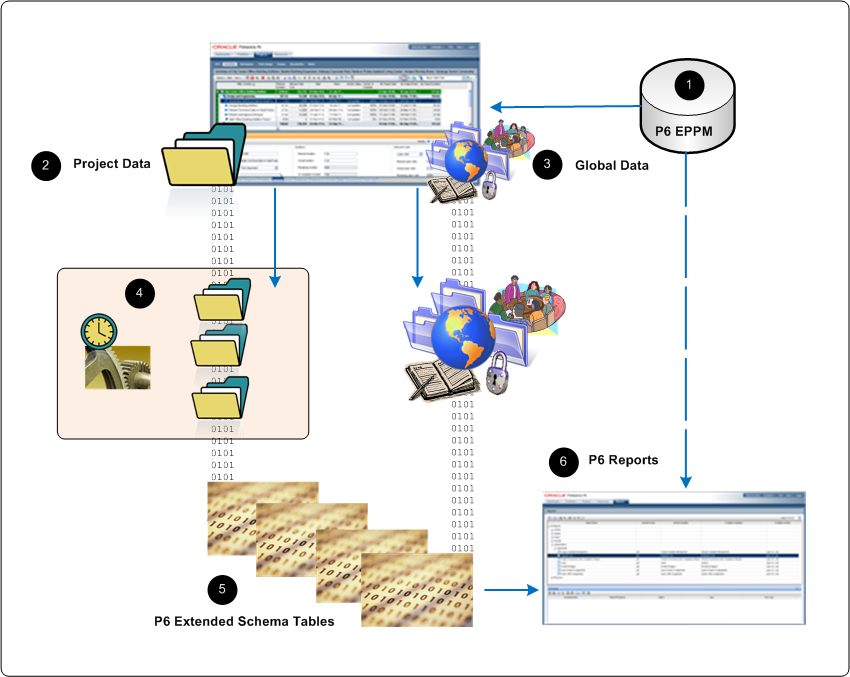To achieve near real-time reporting, team usage and resource analysis, you can configure P6 to automatically publish to tables that store updated data, including calculations and summary data. These tables also create views for generating reports. The P6 data is split into two general categories: project data and global data. Project data includes all information about your projects, including summaries and calculations. Global data includes enterprise data, as well as resource and role, portfolio, and security data. The image below summarizes the key concepts in the publication and reporting process.

Table of Key Publication Services Concepts
Item | Description |
|---|---|
| EPPM Database: The EPPM database captures all the data your organization generates every second of every day. However, the raw data in the EPPM database is not structured for immediate reporting. |
| Project Data: You can configure P6 to automatically publish a project based on publication thresholds. Based on the options you select, you can prioritize projects for publication in a queue. If necessary, you can manually add a project to the queue. |
| Global Data: You can configure services in P6 to schedule the publication of global data based on recurring intervals that you specify. If necessary, you can also immediately publish this data manually. |
| Project Queue: Projects publish in sequential order based on priority. Your administrator can control which projects are added to the publishing queue, when, and in what order. These options ensure the project data you need most is available for P6 in near real-time. |
| P6 Extended Schema Tables: The project and global services recalculate certain logical fields in the P6 EPPM database and store them as physical fields in the P6 Extended Schema tables so they are available for reporting and other purposes. Some fields in P6, such as durations, are calculated in real time as related field data is changed and are not stored in the database. Publication services recalculate these fields and store their values in the extended schema tables. Other fields, such as note fields, are not stored in the database in a format suitable for reporting. For these fields, publication services will convert them to a format more suitable for reporting. Note: For information about which tables are updated by the Publication Services, see the following knowledge management document: What PX tables are updated when running Global Scheduled Services or Publish Project [ID 1491245.1] https://support.oracle.com/epmos/faces/ui/km/DocumentDisplay.jspx?id=1491245.1 |
| P6 Reports: You can run reports directly against P6 Extended Schema table views. |
P6 administrators control project and global publication processes, which are summarized below.

Table of Key Publication Services Elements
Item | Description |
|---|---|
| Application Settings for Publication Services: Located under the Administration tab, begin by clicking Application Settings, and then choose Services. On the Services page, specify the start date, period of time to add to the current publication date to determine a finish date, and time-distributed interval for publication. In the Project Publication section, you can enable the Publish Projects services to refresh project data according to a time interval you set. You can further determine a change threshold, time threshold, and even decide if idle projects should be added to the queue, and if so, set a maximum limit to the concurrent number of idle projects being published. |
| Project Preferences for Publication Services: Then, navigate to the EPS page in the Projects section. Click a project and select Set Project Preferences from the Actions menu or the Row Actions menu. On the Services or Analytics and Services page, select the Enable Publication option to indicate you want to include this project in the Publish Projects services. All new projects are enabled for publication by default. Clear the option if you do not want to publish the project's data. On this page, you can also set the project's priority relative to other projects entering the publication queue. |
| Global Scheduled Publication Services: Return to the Administration tab and navigate to the Global Scheduled Services dialog box to enable the types of global data services you want to schedule. Below each service you enable, specify the recurring interval and start time in the detail window. |